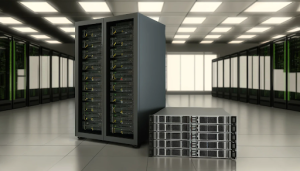In today’s digital battlefield, reliable server infrastructure is the backbone of any successful business operation. Choosing the right server type, whether Node or Blade, depends on the specific demands of your mission. This guide equips you with the essential tactics to effectively manage either server environment and keep your data safe and secure.
Know Your Warriors: Unveiling Node and Blade Servers
- Node Servers: These self-contained server units are like lone wolves: cost-effective and ideal for predictable workloads and limited space. They’re a great choice for smaller businesses or those with consistent resource needs.
- Blade Servers: Imagine a high-density platoon of powerful servers housed within a single chassis. This is the essence of a Blade server – perfect for data centers with fluctuating workloads or demanding computing needs. Blade servers offer exceptional scalability and resource optimization, allowing you to easily add more processing power as your needs grow.
Essential Maneuvers for Both Server Types
- Hardware Hygiene: Regularly clean dust from vents and fans, just like maintaining a healthy warrior. Monitor component health (temperature, storage) to identify potential issues before they erupt into major problems. Don’t forget to keep your server’s firmware up-to-date – it’s like giving your server a software suit of armor!
- Software Sharpening: Maintain consistent update schedules for operating systems, applications, and security software. These updates are essential for optimal performance and ensuring your defenses stay impenetrable against cyber threats.
- Configuration Consistency: Utilize configuration management tools to automate server configuration tasks. This ensures consistency across all your servers and minimizes the risk of human error – no rogue agents here!
- Monitoring and Alerting: Deploy monitoring tools to track performance metrics, resource utilization, and potential issues. Set up alerts to be notified before problems disrupt operations, allowing you to address them proactively.
- Security Measures: Enforce strong passwords and user access controls. Think of these as secure checkpoints and authorization protocols. Additionally, implement robust firewalls and antivirus software to shield your servers from cyber threats, making them impregnable fortresses.
- Backup and Disaster Recovery: Be prepared for the unexpected! Develop a comprehensive backup and disaster recovery plan. Regularly back up your server data and have a plan in place for swift recovery in case of unexpected outages. This ensures your data is always protected and readily available.

Blade Server Specifics: Advanced Tactics
- Chassis Management: Blade chassis require additional monitoring of power consumption, cooling efficiency, and potential hardware failures within the chassis itself. It’s like monitoring the overall health of your server army in addition to individual units.
- Blade Server Maintenance: While individual blades can be swapped for maintenance, ensure proper handling procedures are followed to avoid damaging other components within the chassis. Think of it as carefully rotating troops in and out of battle formations.
Choosing Your Weapon: Node vs. Blade
Both server types have their strengths and weaknesses. Node servers are cost-effective and easy to manage for predictable workloads, but lack scalability. Blade servers offer exceptional scalability and resource optimization, ideal for fluctuating workloads, but come with a higher upfront cost and more complex management. Consider your specific needs before choosing your weapon.

Cloud Ninjas: Your IT Strategist
Managing a complex server environment, whether Node or Blade, can be a demanding task and comes with various pros and cons. Cloud Ninjas offers a range of solutions to streamline your server management and optimize your IT infrastructure, allowing you to focus on your core business objectives:
- Cloud Migration: Explore migrating your workloads to a secure cloud environment. This offloads the burden of managing physical servers, freeing up resources for other business priorities. Cloud Ninjas provides expert migration services to ensure a smooth transition.
- Managed Cloud Services: Consider managed cloud services for your existing infrastructure. Cloud Ninjas’ team of specialists can handle routine maintenance, security updates, and performance monitoring, allowing your IT staff to focus on strategic initiatives. It’s like having a dedicated support unit handling the server logistics while your IT team spearheads key operations.
- 4U18N-B550 2T AMD Ryzen 4U 18 Node Server: For businesses requiring a high-density, scalable Node server solution, Cloud Ninjas offers the B550 AMD Ryzen 4U 18 Node Server. This powerhouse features 18 individual nodes, each equipped with AMD Ryzen processors and ample storage, making it ideal for applications requiring high core counts and efficient resource utilization. It’s like having a powerful and versatile army at your disposal.
Conclusion
By mastering these server management best practices, you can ensure optimal performance and security for your Node or Blade server environment. Additionally, by exploring Cloud Ninjas‘ cloud solutions and innovative server offerings, you can unlock new levels of efficiency and scalability for your business. Remember, a well-maintained server environment is



